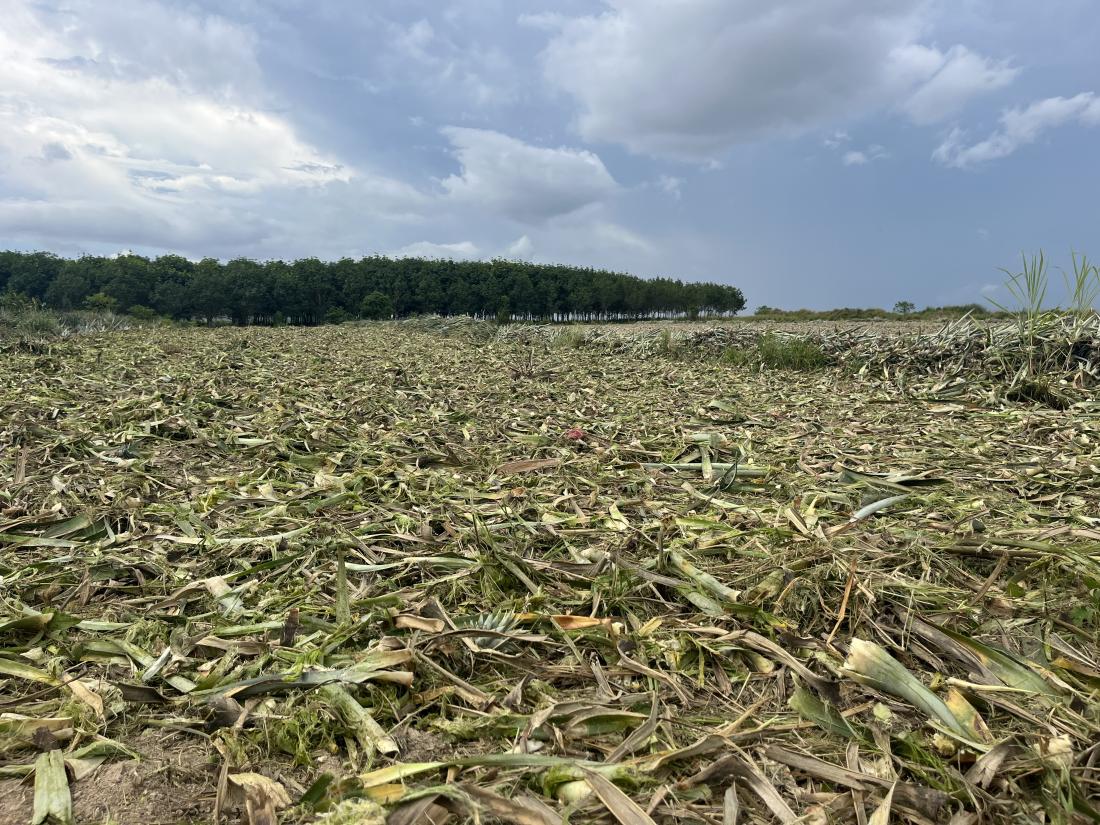Pineapple farm in Thailand
In this groundbreaking study, Associate Professor Taweechai Amornsakchai from Mahidol University, Thailand led his team researchers to successfully developed a biodegradable starch film derived from pineapple stem waste, offering a sustainable alternative to non-biodegradable petroleum-based films commonly used for single-use applications that do not require high strength. The key ingredient utilized in this film is high amylose starch extracted from pineapple stems, which serves as the matrix for the material. To enhance its ductility and flexibility, glycerol and citric acid were incorporated as additives.
Maintaining a fixed glycerol content of 25%, the researchers experimented with varying levels of citric acid, ranging from 0% to 15% by weight of starch. This approach allowed for the preparation of films with a wide spectrum of mechanical properties, catering to diverse application requirements. As the concentration of citric acid increased, the resulting film exhibited a softer and weaker nature while demonstrating enhanced elongation at the point of fracture. The mechanical properties of the films spanned a broad range, from a strength of approximately 21.5 MPa with 2.9% elongation, to a strength of about 6.8 MPa with 35.7% elongation.
To gain further insights into the structure of the films, X-ray diffraction analysis was performed, revealing their semi-crystalline nature. Additionally, the films displayed desirable water-resistant properties and the ability to be heat-sealed, opening up potential applications in packaging materials. To showcase the film's viability for single-use purposes, an exemplar single-use package was successfully demonstrated, underscoring its practicality and versatility.
In order to validate the biodegradability of the material, a soil burial test was conducted. The results unequivocally confirmed that the starch film was biodegradable, as it completely disintegrated into particles smaller than 1 mm within a remarkably short span of one month. This promising characteristic suggests that the film has the potential to significantly mitigate the adverse environmental impact associated with the persistence of non-biodegradable materials.
The development of this biodegradable starch film from pineapple stem waste holds immense promise for addressing the growing concerns regarding the proliferation of non-biodegradable packaging materials. By utilizing an abundant and renewable agricultural byproduct, the researchers have not only offered an eco-friendly alternative but have also contributed to the efficient utilization of resources and waste reduction. Furthermore, the incorporation of glycerol and citric acid additives allows for customization of the film's mechanical properties, enabling it to cater to a wide array of applications where strength requirements are not excessively demanding.
This study serves as a significant milestone in the pursuit of sustainable materials for single-use applications, showcasing the potential of biodegradable films derived from agricultural waste. The findings highlight the importance of exploring innovative approaches to address environmental challenges and emphasize the feasibility of transitioning from petroleum-based materials to renewable alternatives. As the demand for eco-friendly solutions continues to escalate, the development of biodegradable starch films from pineapple stem waste represents a noteworthy contribution to the field of sustainable materials and paves the way for a greener and more sustainable future.
Associate Professor Kheng Lim Goh from Newcastle University in Singapore, who serves as the technical advisor to the Amornsakchai team, expressed great satisfaction in being able to contribute to the efforts of his colleagues. He commended the team's exceptional performance in accomplishing this significant milestone. The Amornsakchai team possesses a distinct advantage in ensuring that their research creates a beneficial impact in Thailand, Malaysia, and the broader ASEAN region.
The findings from this study has been published in a paper [1] in the journal called membranes. The details of the findings can be found at doi.org/10.3390/membranes13050458
For more information, please write to Associate Professor Taweechai Amornsakchai at [email protected] or to Associate Professor Kheng Lim Goh at [email protected].
Reference
[1] A. Namphonsane, P. Suwannachat, C. H. Chia, R. Wongsagonsup, S. M. Smith, and T. Amornsakchai, "Toward a Circular Bioeconomy: Exploring Pineapple Stem Starch Film as a Plastic Substitute in Single Use Applications," Membranes, vol. 13, no. 5, p. 458, 2023. [Online]. Available: https://www.mdpi.com/2077-0375/13/5/458.



